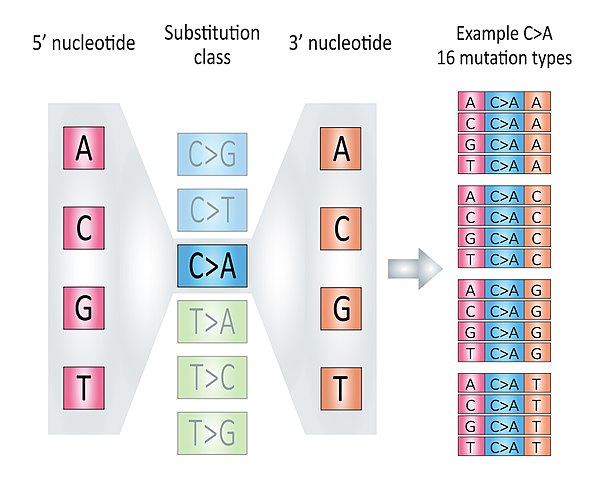拿到突变的数据之后,一般会先看除了进行突变注释,看突变所在的基因和造成的氨基酸变化,还会看具体的碱基变化类型,共96种,以三个碱基为统计单位,看三联核苷酸中间的碱基变化类型的个数,以C变为A为例(等同负链G变为T),NCN>NAN,N可以为任意碱基,所以有4*4=16种,所有情况为96种。

统计96种突变类型的具体数目,之后会进行突变的signature分析有三种:
- 与已知的cosmic signature进行比较,看哪些signature比重高
- 利用非负矩阵分解NFM找novel的signature
- 分析1和2之后,看novel的signature和已知的signature的相似性
突变的signature是内外部环境共同作用下造成的一些特定的变异特征,这些因素包括DNA修复或者复制缺陷,吸烟饮酒等等。
找cosmic的signature
利用R包deconstructSigs进行
1
2
3
4
5
6
7
8
9
10
11
12
13
14
15
16
17
18
19
20
21
22
23
24
25
26
|
# 假设你有一个数据框,包含了突变的信息,以包自带的sample.mut.ref为例
head(sample.mut.ref)
# Convert to deconstructSigs input,得到96碱基突变数据框
# 指定染色体位置、突变碱基和样本名所在的列名
sigs.input <- mut.to.sigs.input(mut.ref = sample.mut.ref,
sample.id = "Sample",
chr = "chr",
pos = "pos",
ref = "ref",
alt = "alt")
# 提取样本的mutation signature
# 这里的signature.nature2013或者signatures.cosmic就是参考的signature,如果你有自己的signature数据,比如SomaticSignatures包找到的,也可以在这个地方指定,这样就计算的是提供的singature
sample_1 = whichSignatures(tumor.ref = sigs.input,
signatures.ref = signatures.nature2013, # 参考signature
sample.id = 1, # 样本的barcode
contexts.needed = TRUE,
tri.counts.method = 'default' # 是否进行normalzie
)
sample_1$weights[1:3]
# Signature.1A Signature.1B Signature.2
#1 0 0.1564832 0
|
找novel的signature
利用SomaticSignatures包进行,这里找到的novel signature可以作为参考的signature用deconstructSigs,注意96突变类型数据框的名应一致。

